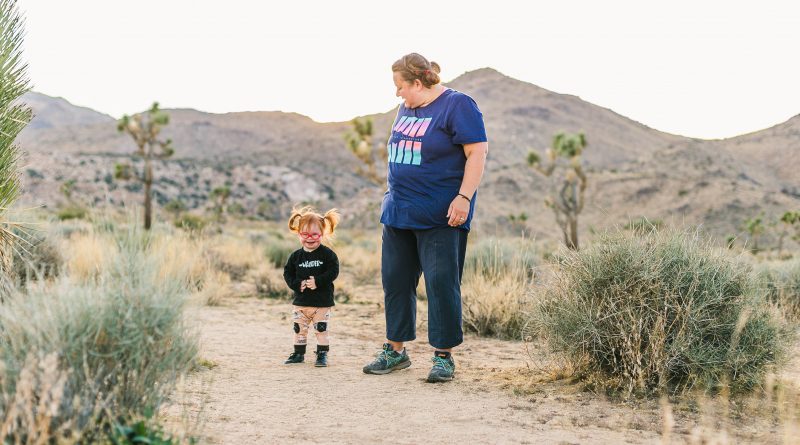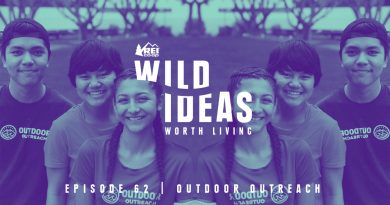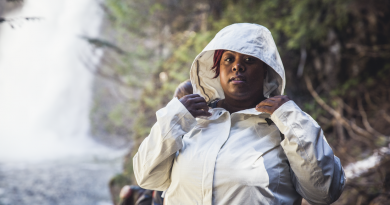How Hiking Helped a Utah Mom Connect With Her Daughter With Special Needs
Spending time outdoors has created a unique bond between Melody Buck Forsyth and Ruby, who was born with Down syndrome. Through their goal to visit all 59 national parks, the family hopes to inspire others.
Many people contemplating parenthood may think having a child will significantly scale back their adventuring. For Salt Lake City mom Melody Buck Forsyth, this was definitely true in 2015 when she learned she was expecting her fourth child. She had only recently discovered her passion for hiking. To complicate things, she found out her daughter would be born with Down syndrome.
“I remember thinking, ‘OK, we’re not going to be able to do much anymore, especially not things outside, so we better get it out of our system.’”
Melody and her husband, Victor, had gotten married in Colorado’s Mesa Verde National Park in 2005 and had always wanted to visit another national park. They thought it would be fun to bring the whole family on one last big trip around the Southwest before Ruby was born. Inspired by a picture of The Narrows they’d seen in a magazine, they decided to visit Zion National Park.
“It was in a restaurant in Zion that I realized life didn’t have to change so much. I saw a family sitting there with a child in a wheelchair and I remember thinking, ‘Well, they are doing it … why can’t we?’”
The weeklong trip was a huge adventure for her normally not very active family. Melody and Victor and their three kids charged up The Narrows, hiked to Emerald Pools and explored Weeping Rock. At the end of each day, they were exhausted, but their two sons, ages 8 and 6, and 15-year-old daughter were so excited about their adventures. Melody could tell they had caught the hiking bug as well. Although she was more optimistic than the rest of the family that they would find a way to adventure with their new little one, she also tried not to get her hopes up too much. She had no idea what their future would look like.
During pregnancy and shortly after Ruby was born, Melody found it harder to connect with her daughter. “It was just different than it had been with my other children. It felt more forced and awkward because Ruby didn’t respond the way my other three babies had, smiling and hugging back. Babies with Down syndrome are sort of limp so you have to carry all of their weight.”
Perhaps because she was overwhelmed with Ruby’s medical needs or maybe because she was suffering from some postpartum depression, Melody said it wasn’t until her baby was about 10 months old that she first felt that connection.
“The doctor gave us the OK to go adventure with her because she was off of oxygen full-time and only needed it at night. Also, I didn’t have to pump every few hours, so all of these things combined gave me the push I needed to get her in a pack and go hiking,” says Melody.
“Carrying Ruby on trails felt like our thing,” says Melody, Joshua Tree National Park, December 2017. (Photo Credit: Arika Bauer)
She got an Osprey Poco child carrier and that was it; she hit the trails around Salt Lake City with Ruby. That’s when they began to click. “Carrying Ruby on trails felt like our thing. I could just feel how excited she was to be outside and it bonded us. Even now my husband offers to carry her but I want to carry her because I feel like it shows Ruby I am always going to be there for her.”
As Melody worked toward connecting with Ruby through hiking, it came out that her then 16-year-old daughter, Angelina, was struggling with some serious teenage depression. This translated to suicide threats.
“I had this new baby who needed me and now my oldest was actually having such a rough time that the doctors said I needed to be with her 24/7, as well. So, I would do everything, including napping, with the two girls,” says Melody. “I knew if I took Angelina with me everywhere, she was safe.”
She started planning hikes three to four times a week, bringing both her oldest and youngest daughters with her. Slowly, Angelina got better, Melody says. “Hiking became an outlet for my sanity, and it helped my connection with both of my daughters.”
Hiking has created a special bond for Melody and Ruby, Joshua Tree National Park, December 2017. (Photo Credit: Arika Bauer)
Around the same time, Melody also began noticing more pictures on Instagram and Facebook showing “real” women out hiking who looked more like her. Inspired, she joined 52 Hike Challenge and Hike it Baby 30, two challenges to get her family out hiking regularly—though it took some convincing.
“The thing I could remind them of if they were whining about going out was that they were never going to finish a hike and say, ‘Oh, I wish we hadn’t done that.’”
Over time, the family started taking hiking more seriously. As they talked about future adventures, the idea of a national parks bucket list kept coming up. That motivated Melody to start @Downwithadventure, an Instagram account dedicated to showing the world their family adventures with Ruby as they try to visit all 59 national parks. She noticed how positively people reacted when they saw Ruby on the trail and how this continued online. “I think people aren’t used to seeing a toddler with Down syndrome on the trail and so I wanted to help show everyone it can be done.”
Melody hikes with Ruby in Death Valley National Park. (Photo Courtesy: Melody Buck Forsyth)
To date, the family has hiked in 26 national parks and monuments and Ruby is only 2 years old. Although it helps that they live in Utah, where there are five national parks and a never-ending list of amazing state parks. Their goal for summer 2018 is to visit Sequoia National Park and hopefully take a trip up to Oregon where they want to hike around Crater Lake.
For parents who are struggling to get their kids outside—whether they have a disability or not—Melody offers this piece of advice: “It’s not always going to be perfect every time. Sometimes you just might make it to the park and that’s it,” she says. “I want to paint a positive attitude of families getting out there with children with disabilities. Not to be all Pollyanna, but I am a very keep-it-real person, so I want to show the speed bumps and the hard parts too. There is so much good and happiness that can come from hiking with your children. My goal is to just enjoy this time with my family; the good days and the bad days show it all.”
Photo Credit: Arika Bauer
Melody’s 8 Tips for Getting Out There with Kids with Disabilities
- Talk to your doctor about what you want to do and make a plan. You don’t have to aim for climbing a fourteener right off the bat, but don’t be afraid to take steps to get outside when you feel ready.
- In the beginning, look for trails with wheelchair accessibility. Wheelchair trails will often have amenities you might need like bathrooms, water and park rangers.
- Don’t hesitate to park in handicapped-accessible spots (so long as you have the appropriate permit). You might need to get to your car quicker than most families, and it makes a big difference if you can drive right to the start of a trailhead versus having to trek in a little ways. You’ll appreciate it at the end of the hike if you need oxygen, diapers and quick access to food.
- Try different child carriers. Don’t get stuck on one carrier. Your child’s body will change as they age, and you will need different carriers over time. Don’t skimp on a carrier because a comfortable one will make all the difference for both you and your child. There are many frame and soft-structured carriers that will work for kids up to 6 years or older.
- Look for a community to join. Hike it Baby is one community that offers all-access hikes in some cities and is a good way to link up with parents who have children with disabilities. It’s also a community that adheres to the guiding principle of leaving no family behind.
- Know what you are getting into. Check the distance, elevation gain and read a lot of reviews. National parks spell everything out really well, so they are a fairly good bet if you are just beginning to explore the outdoors.
- Start with flatter trails. This ensures everyone can move along in the group and you don’t have to wait and help each other over things or up steep areas.
- Consider cell service and how remote the trail is. If you have any medical concerns, you might want to stick to trails that are closer to civilization until you are more comfortable with getting your child out.
The Forsyth family is trying to visit all 59 national parks. They visited Joshua Tree National Park in December 2017. (Photo Credit: Arika Bauer)
The post How Hiking Helped a Utah Mom Connect With Her Daughter With Special Needs appeared first on REI Co-op Journal.
Originally posted 2018-02-10 18:31:39.




